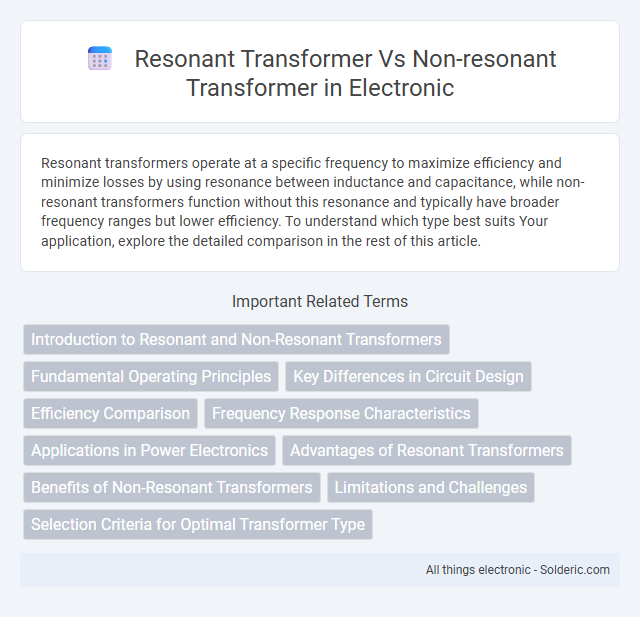Resonant transformers operate at a specific frequency to maximize efficiency and minimize losses by using resonance between inductance and capacitance, while non-resonant transformers function without this resonance and typically have broader frequency ranges but lower efficiency. To understand which type best suits Your application, explore the detailed comparison in the rest of this article.
Comparison Table
| Feature | Resonant Transformer | Non-Resonant Transformer |
|---|---|---|
| Operating Frequency | High frequency, tuned to resonance | Wide frequency range, not tuned |
| Efficiency | Higher efficiency due to reduced core losses | Lower efficiency, higher core and copper losses |
| Voltage Regulation | Better voltage regulation under load | Less stable voltage regulation |
| Size and Weight | More compact and lightweight | Larger and heavier due to core design |
| Applications | Wireless power transfer, induction heating, RF circuits | Power distribution, standard transformers, electrical isolation |
| Complexity | Higher complexity with tuning circuits required | Simpler design, easier to implement |
| Cost | Generally higher due to precise components | Lower manufacturing cost |
Introduction to Resonant and Non-Resonant Transformers
Resonant transformers operate by utilizing the principle of resonance, where inductive and capacitive reactances cancel each other out at a specific frequency, enabling efficient energy transfer with minimal losses. Non-resonant transformers rely solely on electromagnetic induction without exploiting resonance, resulting in broader frequency operation but typically higher core and copper losses. Resonant transformers are ideal in applications requiring high efficiency and specific frequency tuning, while non-resonant transformers suit general power distribution where wide bandwidth and simplicity are priorities.
Fundamental Operating Principles
Resonant transformers operate using the principle of resonance, where the inductive and capacitive reactances balance at a specific frequency to maximize energy transfer efficiency and minimize losses. Non-resonant transformers rely primarily on magnetic induction without frequency tuning, resulting in broader operational bandwidth but typically lower efficiency at high frequencies. Your choice between these depends on the application's frequency requirements and efficiency goals.
Key Differences in Circuit Design
Resonant transformers utilize LC circuits to achieve frequency resonance, significantly reducing energy loss and improving efficiency in high-frequency power applications. Non-resonant transformers rely on conventional fixed-frequency operation without tuned components, resulting in simpler design but higher core losses and lower efficiency at variable frequencies. The presence of capacitive elements in resonant transformers enables voltage amplification and harmonic filtering, unlike the primarily inductive design of non-resonant transformers.
Efficiency Comparison
Resonant transformers typically exhibit higher efficiency compared to non-resonant transformers due to reduced switching losses and minimized electromagnetic interference during operation. The resonant operation allows energy transfer at the transformer's natural frequency, optimizing power delivery and reducing heat dissipation. Non-resonant transformers, while simpler in design, often suffer from greater core losses and lower power factor, leading to decreased overall efficiency.
Frequency Response Characteristics
Resonant transformers exhibit sharply defined frequency response characteristics with high selectivity and efficiency at their resonant frequency, making them ideal for applications requiring minimal signal loss and precise tuning. Non-resonant transformers provide a broader frequency response but with lower efficiency and higher losses across the spectrum, suitable for general power transfer rather than frequency-specific operations. The quality factor (Q) of resonant transformers significantly enhances frequency stability and reduces harmonic distortion compared to the more uniform but less specialized response of non-resonant transformers.
Applications in Power Electronics
Resonant transformers are widely used in power electronics applications requiring high efficiency and reduced electromagnetic interference, such as wireless power transfer, induction heating, and resonant converters for DC-DC conversion. Non-resonant transformers find common use in traditional power supplies, isolation, and voltage step-up or step-down tasks where simplicity and robustness are preferred over efficiency optimization. The choice between resonant and non-resonant transformers depends on factors like frequency range, power level, and the need for minimized switching losses in power electronic circuits.
Advantages of Resonant Transformers
Resonant transformers offer higher efficiency due to reduced core and copper losses by operating at their natural resonant frequency, which minimizes energy dissipation. These transformers enable compact designs with lighter weight and smaller size, making them ideal for high-frequency applications like wireless power transfer and induction heating. You benefit from improved voltage regulation and lower electromagnetic interference compared to non-resonant transformers, enhancing overall system performance.
Benefits of Non-Resonant Transformers
Non-resonant transformers offer stable and predictable performance across a wide frequency range, making them ideal for applications requiring consistent voltage regulation. They typically have lower electromagnetic interference (EMI) due to the absence of resonance peaks, enhancing system reliability in sensitive electronic environments. Additionally, non-resonant transformers are generally simpler in design and manufacturing, leading to reduced costs and improved durability.
Limitations and Challenges
Resonant transformers face challenges including complex circuit design and sensitivity to load variations, which can impact efficiency and stability. Non-resonant transformers are limited by higher core losses and lower efficiency at high frequencies, restricting their performance in compact, high-frequency applications. Both types encounter thermal management issues, but resonant transformers require precise tuning to maintain optimal resonance conditions.
Selection Criteria for Optimal Transformer Type
Choosing between a resonant transformer and a non-resonant transformer depends on factors like efficiency, frequency range, and application requirements. Resonant transformers are ideal for high-frequency applications needing minimal losses and precise voltage regulation, while non-resonant transformers suit low-frequency, general-purpose power transfer with simpler design constraints. Your selection should consider operational frequency, desired efficiency, size constraints, and electrical noise tolerance to ensure optimal performance.
resonant transformer vs non-resonant transformer Infographic

 solderic.com
solderic.com